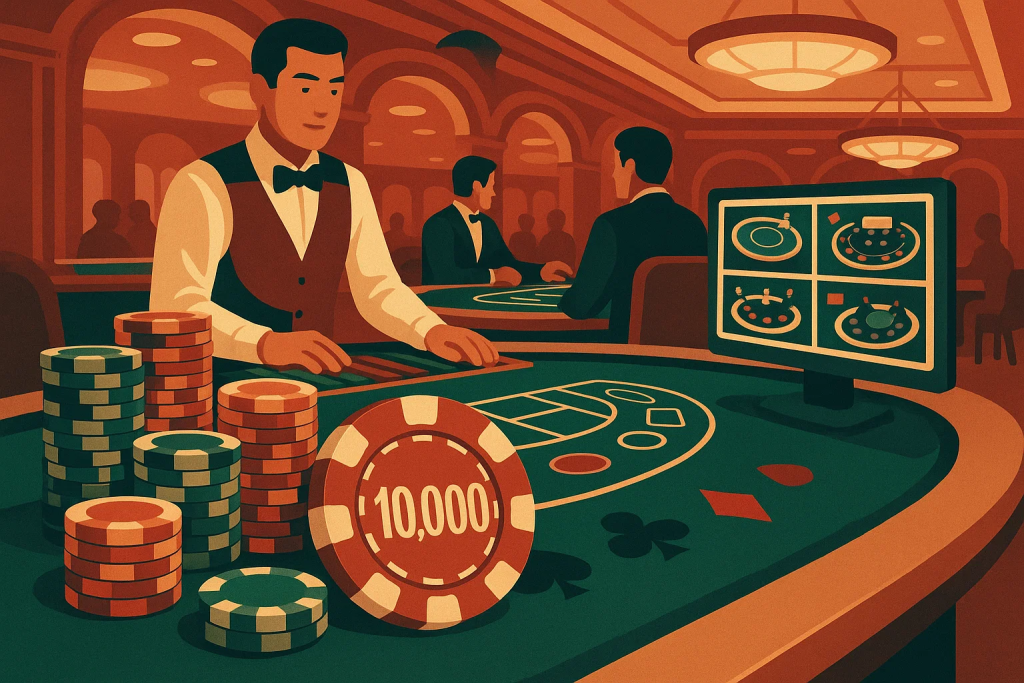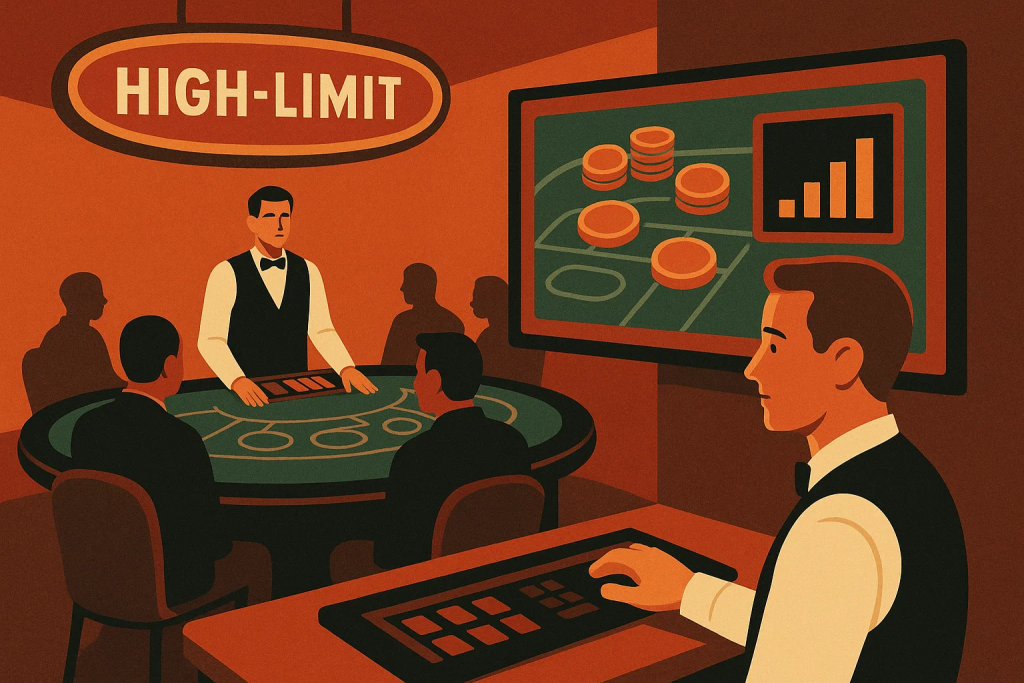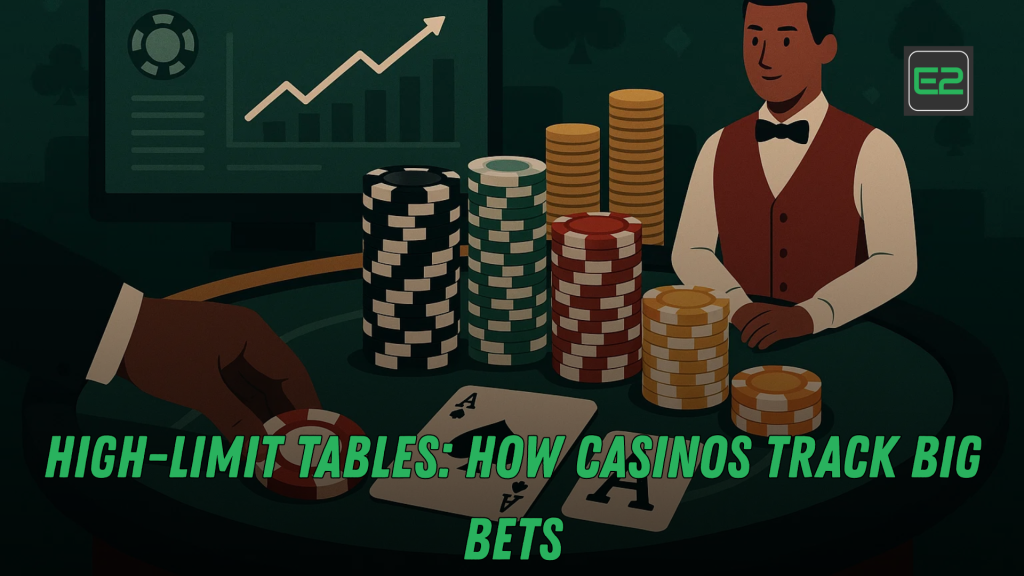Table of Contents
Executive Summary (TL;DR)
Casinos invest serious money in monitoring high-limit tables because a single shoe of baccarat or a run at double-deck blackjack can swing six or seven figures. Tracking isn’t just about catching cheaters; it’s about game protection, fair rating for comps and credit, anti–money laundering (AML) compliance, and a premium guest experience. From RFID chips and intelligent shoes to pit-boss logs, player cards, hosts, and computer vision, every layer reduces risk while rewarding legitimate play. This guide explains the full stack behind high-limit tables, what data gets captured, how it’s used, and how players can advocate for transparency while gambling responsibly.

The Business Case Behind Big-Bet Tracking
When you walk into a velvet-roped pit and hear the measured quiet of high-limit tables, you’re entering a controlled environment. Dealers, floor supervisors, surveillance operators, analysts, hosts, cage managers, and even compliance officers all coordinate around one objective: precision. Precision in game integrity, in player identity, in trip theoretical (“theo”) calculations, and in credit and comp decisions. The greater the stakes, the smaller the tolerances for error. That’s why high-limit tables run on a tighter playbook than the main floor.
This article demystifies that playbook. You’ll learn the concrete steps casinos use to identify players, time action, rate decisions, analyze betting patterns, and satisfy regulators—without turning the room into a police state. You’ll also see how to ask smart questions about your ratings at high-limit tables, and why the best operators treat mental health, privacy, and responsible play as part of the product.
What Exactly Counts as “High Limit”?
There’s no single definition. A resort may brand any pit with minimums above $100 as high-limit tables, while boutique rooms start at $500 or $1,000 per hand. Limits vary by game:
- Baccarat: $500–$100,000+ per coup
- Blackjack (hand-shuffled or double deck): $100–$25,000+ per hand
- Roulette (single zero preferred): $100–$10,000+ on inside, higher on outside
- Craps (in the salon): $100–$5,000+ line with proportional odds
Regardless of the posted sign, if the room has dedicated hosts, separate surveillance focus, and bespoke rules or equipment, you’re effectively at high-limit tables.
The Tracking Stack: Layers That Work Together
Think of monitoring at high-limit tables as a layered system. No single tool is perfect; together they create reliability.
1) Player Identity & Enrollment
- Players club (loyalty) card. The simplest anchor for identity. Tapping in at high-limit tables links wagers to a profile with previous trips, average bet, trip theo, credit lines, and host assignments.
- Casino markers (credit). High-stakes guests often take markers; legal paperwork ties identity to betting activity and repayment terms.
- Hosts & VIP services. Human relationships matter in high-limit tables. Hosts know habits—games, times of day, preferred dealers—and validate that the person playing is the person rated.
2) Game Hardware & Sensors
- RFID-enabled chips. Each chip has a tiny tag that signals denomination and position. Readers embedded in layouts (“intelligent tables”) tally wagers on high-limit tables in real time.
- Intelligent shoes (blackjack/baccarat). Track card flow, cut-card penetration, and potential anomalies; they help pace games at high-limit tables and feed analytics.
- Overhead and pole cameras. High-definition angles allow surveillance to review disputes, verify buy-ins and color-ups, and audit dealer procedures.
3) Software & Analytics
- Table management systems. Combine dealer sign-ins, player ratings, chip reads, and hand/coup counts to calculate accurate average bet and time-on-device at high-limit tables.
- Advantage-play indicators. Statistical flags look for improbable bet-timing, hole-carding cues, or roulette ball bias—signals that merit a closer look (without jumping to conclusions).
- Compliance integrations. Data from high-limit tables routes to AML/KYC modules that watch for thresholds (e.g., cash transactions requiring reporting) and unusual patterns.
4) Human Oversight
- Pit bosses & floor supervisors. They validate chip counts, watch betting progressions, and update ratings by eye when technology misses nuance at high-limit tables (e.g., last-minute press).
- Surveillance (“the eye in the sky”). An independent team with authority to review and escalate. Their role at high-limit tables is equal parts protector and referee.
What Data Is Captured—and Why It Matters
Casinos don’t need your life story to run high-limit tables; they need specific datapoints that map risk and reward.
- Identity & credit status: Card number, host assignment, marker limits.
- Buy-in & color-up: Cash vs. chips vs. marker; timestamps; denominations.
- Average bet & time played: Basis for theoretical loss; the backbone of comping at high-limit tables.
- Game speed: Hands per hour (blackjack), coups per hour (baccarat), decisions per hour (roulette/craps).
- Volatility & house edge: Rule sets (e.g., blackjack S17/H17, DAS, RSA) and side bets affect theo; high-limit tables often tweak rules for comfort or speed.
- Exception events: Disputes, hole-card exposures, off-layout chip placements, or late bets.
The result is a living profile: accurate enough to offer fair comps, conservative enough to protect the room, and clean enough to satisfy auditors.
How Theoretical (“Theo”) Is Calculated at High Stakes
At high-limit tables, theo is the currency that converts time and average bet into comps and credit decisions. A simplified formula:
Theo = Average Bet × Decisions per Hour × House Edge × Hours Played
Example (blackjack):
- Average bet: $1,500
- 80 hands/hour
- House edge: 1.1% (rule-dependent)
- 3 hours played
- Theo ≈ $3,960
Casinos will comp a fraction of theo (often 20–40%, policy-dependent). Accurate tracking at high-limit tables ensures your meals, room, or airfare reflect actual play.
AML, KYC, and Why Compliance Lives in the Room
Regulators expect controls where risk is highest—at high-limit tables. Core elements:
- KYC (Know Your Customer). Matching identity to play, especially when chips move between players or between pits.
- CTR-like thresholds & reporting. Large cash buy-ins or redemptions may trigger paperwork; staff at high-limit tables are trained to escalate.
- Source-of-funds checks (some markets). Hosts and cage collaborate when patrons request unusual credit or settle markers in atypical ways.
Compliance isn’t about distrust; it’s about protecting the license and maintaining integrity where the action is biggest.
Game-by-Game: What Tracking Looks Like
Baccarat
- Why it’s king. Simple decisions, huge volume, and superstition-driven streak chasing make baccarat the flagship of high-limit tables.
- Data highlights. RFID chips tally Banker/Player/Tie bets; shoes track shoe depth; pit logs mark side-bet exposure.
Blackjack
- Edge management. Rules (S17 vs. H17, resplit aces, surrender) swing house edge; high-limit tables often standardize favorable rules to attract informed players.
- Monitoring cues. Bet variation near shuffle points, frequent table changes, and side-seat peeks are reviewed against normal variance.
Roulette
- Bias and rhythm. Smart layouts and camera reviews protect high-limit tables from wheel bias exploitation or post-spin chip-splashes.
- Chip auditing. Color and denom control improve accounting during big color-ups.
Craps (in the salon)
- Bankroll velocity. Line + odds can escalate rapidly; high-limit tables use dual verification on buy-ins, markers, and payouts.

Manual vs. Automated: Why Both Matter
Automated sensors can miss late presses, splashed stacks, or dealer calls in noisy moments. Conversely, humans misestimate average bets during fast swings. The best run high-limit tables pair precise hardware with empowered floor teams:
- Dealer accuracy. Dealers announce bet sizes clearly; supervisors confirm unusual stacks.
- Rating discipline. Floor updates ratings during obvious shifts (e.g., sustained press from $1,000 to $5,000).
- Exception logging. When something odd happens, note it immediately; stale memories are unreliable.
Protecting Guests: Privacy, Data, and Dignity
High rollers value discretion. Good policy at high-limit tables includes:
- Minimal necessary data. Collect only what operations and law require.
- Role-based access. Hosts don’t see surveillance notes; surveillance doesn’t see health data.
- Plain-language notices. Post what’s recorded at high-limit tables and why (ratings, security, compliance).
- No spectacle. Escalations happen away from the felt; respect is a competitive advantage.
Advantage Play vs. Cheating: The Line That Matters
Casinos expect skilled guests. Card counting, for example, is legal in many jurisdictions when unaided—though operators may limit or refuse action. Cheating (devices, signaling, past-posting) is criminal. At high-limit tables, staff are trained to distinguish probability-driven hot streaks from illicit behavior. If a pattern triggers a review, a calm conversation with a shift manager or surveillance liaison often resolves it. Never encourage or attempt to evade lawful controls; the best experience at high-limit tables comes from mutual respect.
Hosts, Comps, and What to Ask For
A strong host relationship helps align expectations with reality at high-limit tables. Tips:
- Before you sit. Ask how the room calculates theo and what fraction converts to comps.
- During play. Use your player card; confirm that your average bet reflects sustained action.
- After sessions. Request a rating review if you significantly increased or decreased bets.
- Trip consolidation. If you split time across several high-limit tables, ask to merge sessions so your theo reflects the whole story.
Dispute Resolution: How “The Eye” Keeps It Fair
Disagreements happen. A chip brushed after “no more bets,” a mis-counted stack, or a premature card burn. At high-limit tables, procedures are crisp:
- Freeze the layout. No one touches chips.
- Call surveillance. Confirm the timestamp and camera angle.
- Review and rule. Supervisors explain the decision and log the outcome.
- Make good. If the house erred, the correction is immediate—credibility is the lifeblood of high-limit tables.
Responsible Play Lives Here, Too
The quiet luxury of high-limit tables can hide the pressure of fast swings. Smart rooms normalize:
- Cooling-off requests. Step away without social penalty.
- Limit settings. Daily loss and time limits on markers and player accounts.
- Support information. Discreet signage and digital resources.
The most trusted brands treat well-being as part of the experience.
A Player’s Checklist Before You Buy In
- Clarify rules (blackjack S17/H17, surrender, baccarat side-bets) at the high-limit tables you’ll play.
- Tap in your loyalty card and confirm recognition.
- Ask how average bet is measured (chip reads vs. manual rating).
- Keep buy-in and color-up receipts.
- Track session time; your theo at high-limit tables depends on it.
- Debrief with your host; align comps with tracked play.
- Take breaks. The room will still be there.
Future Tech: What’s Coming Next
- Computer vision. Better hand recognition and chip inference improve accuracy at high-limit tables without intrusive hardware.
- Real-time comping. Dynamic offers via app as your theo updates mid-session.
- Enhanced privacy controls. Granular consent for marketing vs. operational data.
- AI anomaly detection. Faster, fairer investigations when patterns deviate at high-limit tables.
The aim is a smoother experience: fewer disputes, fairer comps, tighter compliance, and less friction.
Frequently Seen Myths—Debunked
- “They track every word I say.” No—audio recording on the floor is rare and heavily regulated. Visuals and wager data drive decisions at high-limit tables.
- “Ratings are made up.” Ratings are based on formulas and logs, and you can request reviews when they’re off.
- “Asking questions hurts my comps.” Professional rooms welcome informed guests; clarity reduces complaints later.
- “Only whales get fairness.” Good procedure applies to everyone who sits at high-limit tables.
Case Snapshot (Composite): When Tech and People Sync
A guest moves from $1,000 to $6,000 average bets after a lucky shoe. The RFID layout reads most presses, but a late-hand top-off goes uncounted. The dealer announces the stack; the supervisor adjusts the rating; surveillance verifies on playback. The host updates trip theo in the system, and the guest’s comp offer reflects true action. Everyone leaves aligned—a small example of how high-limit tables should work.
The Ethics of the Room
The best operators see high-limit tables as partnerships. Casinos provide protected games, accurate ratings, and discreet service. Players bring honesty, civility, and adherence to table rules. When both sides honor the compact, the environment stays elegant and sustainable.
Call to Action: Ask for Transparency, Play Responsibly
If you’re planning a premium trip, send this article to your host and use it as a conversation starter. Ask how your chosen property tracks wagers, calculates theo, and sets privacy controls at high-limit tables. If something feels unclear, request a supervisor walk-through before you buy in. Great rooms will welcome the dialogue. And regardless of the venue, set limits, schedule breaks, and treat gambling as entertainment—not income.
Final Word
The magic of a great session isn’t luck alone—it’s the confidence that the game is clean, your play is tracked accurately, your privacy is respected, and help is available if you need it. When those pieces click, high-limit tables become what they were meant to be: a refined stage for disciplined risk and memorable hospitality.
Casinos Amazing Collaboration with Pawnshop for Credit: Pawn vs Play
Casinos track high-limit tables to protect game integrity, rate players accurately for comps and credit, meet AML/KYC obligations, and deliver discreet VIP service. “High limit” differs by property but typically features high minimums, dedicated hosts, and bespoke rules across baccarat, blackjack, roulette, and craps.
Monitoring is layered: identity through player cards and markers; hardware such as RFID-enabled chips, intelligent shoes, and HD cameras; software for table management, analytics, and compliance; and human oversight from pit bosses and surveillance. Captured data includes buy-ins and color-ups, average bet, session time, decisions per hour, rule sets (affecting house edge), and exception events.

Theoretical loss (theo) converts play into comps: Average Bet × Decisions/hour × House Edge × Hours, with a policy-defined fraction comped. Compliance at high-limit tables centers on identity verification, reportable cash thresholds, and unusual patterns. Game specifics: baccarat relies on chip RFID and shoe depth; blackjack procedures watch bet variation and rules; roulette protects against bias and late betting; craps verifies rapid bankroll swings.
Best practice blends automation with disciplined manual rating, safeguards privacy, and distinguishes legal advantage play from cheating. Players should confirm rules, use their card, track sessions, and review ratings with hosts. Future tech—computer vision, real-time comping, and better privacy controls—aims for fewer disputes, fairer comps, and smoother experiences.
FAQs
1) What exactly do casinos record at high-limit tables?
Primarily buy-ins, average bet, session length, color-ups, and game-specific decisions. RFID chips, intelligent shoes, and supervisor logs create an audit trail at high-limit tables for rating, security, and compliance.
2) Can I see or dispute my rating?
Yes. Ask a floor supervisor or your host to review. Provide context if your average bet shifted significantly. Professional staff at high-limit tables prefer to fix ratings the same day.
3) Do comps come automatically at high stakes?
Not automatically—comps are policy-driven percentages of theo. Using your player card and confirming session details at high-limit tables ensures accurate offers.
4) Are there extra AML checks for big buy-ins?
Large cash transactions are more likely to trigger reporting. Staff at high-limit tables are trained to escalate discreetly; identity verification and markers simplify documentation.
5) Do responsible gaming tools exist in VIP rooms?
Yes. Reputable operators extend time-outs, limits, and support information to high-limit tables. You can (and should) request these options through your host or a supervisor.
